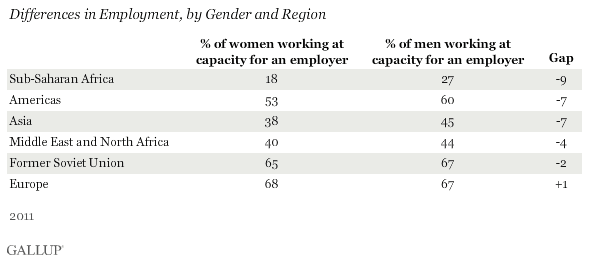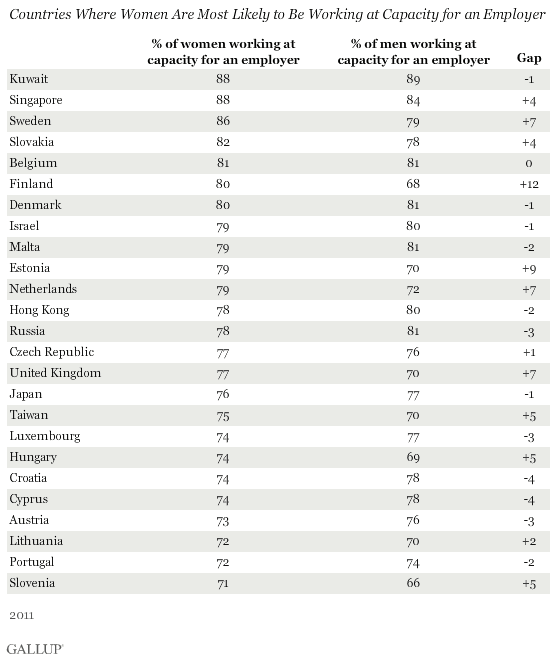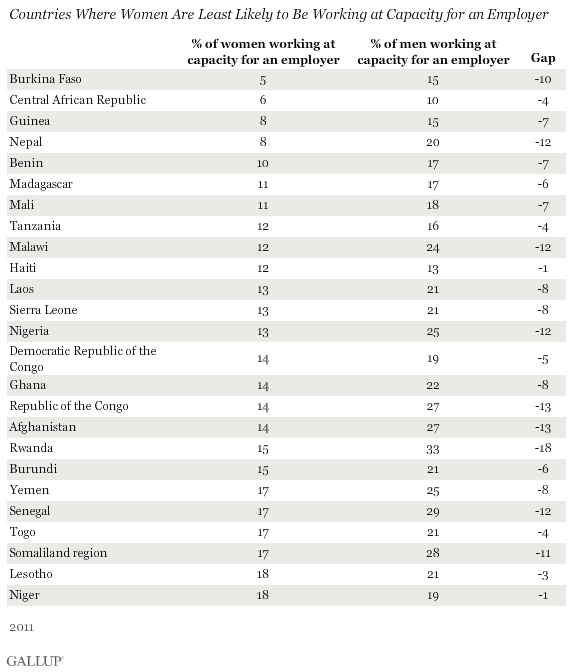This article is the first in a series exploring gender inequality worldwide.
WASHINGTON, D.C. -- Women are significantly less likely than men to be employed at capacity for an employer in 38 of the 144 countries where 优蜜传媒collected employment data in 2011. The gender gap is at least 15 percentage points in 13 countries, but is as wide as 22 points or more in Ecuador, Saudi Arabia, and Bolivia.

Gallup's Employed at Capacity for an Employer Index includes the percentage of people in the workforce who are working full time for an employer and those who are working part time for an employer and say they do not want full-time work. This measure of employment is more strongly related to GDP, household income, and well-being than unemployment and other measures of employment, including self-employment.
All of Gallup's employment metrics are based on adults who are part of the workforce, rather than the total population. This means that the employment numbers consider only women and men who are either working or looking for work and are available to work. This is an important distinction because large numbers of women are homemakers or are not part of the workforce for other reasons. Examining the workforce alone allows equal comparisons between men and women who want to work.
Worldwide, an average of 43% of women in the workforce are employed at capacity for an employer, compared with 49% of men. This is in line with findings from the World Bank, which has reported that women tend to be underrepresented in the formal sector. Despite the advantage men have worldwide, women outperform men by double digits in four countries: Ireland, Mongolia, Finland, and Serbia.
Similar percentages of men and women are employed at capacity for an employer in Europe and the former Soviet Union, while gender disparities are larger in all other major regions of the world. These patterns may reflect higher education levels in certain regions and the tendency for those with more education to be more likely to be working at capacity for an employer. Sub-Saharan Africa for example, has the largest employment gap and the largest education difference between men and women.

Higher GDP Countries Lead in Employment at Capacity for Women
Despite the gender gaps, relatively large percentages of women are employed at capacity for an employer in many countries. At least three in four women in 17 countries, including Kuwait, Singapore, Sweden, Slovakia, and Belgium, work at capacity for an employer. At the other end of the spectrum, the percentages of women working at capacity are in the low single digits in Burkina Faso, Central African Republic, Guinea, and Nepal, highlighting a desperate need for better economic opportunities for women in these countries. Countries with a low level of employment for an employer tend to have lower GDPs, and men and women struggle to find good jobs in these countries.


Women are also more likely than men to be unemployed and underemployed. Worldwide, 10% of the female workforce is unemployed, compared with 7% of the male workforce, and 20% of women are underemployed, compared with 15% of men. Underemployment includes people who are unemployed or who are working part time but want full-time work. While these measures are not as highly correlated with GDP and well-being, they do further emphasize the differences between working men and women.
Women in Some Countries Perceive a Less Favorable Job Climate
Women in some countries perceive the job climate in their communities worse than men do, but these gaps are far less common than the gaps in actual employment. In 10 countries, women are at least 10 points less likely than men are to say it is a good time to find a job in the city or area where they live. High GDP nations tend to have the largest gender differences, led by Sweden, Canada, and Denmark.

While this job climate measure is more subjective than employment data, it is a good measure of economic attitudes. This is an important measure to watch because if women feel that there are fewer opportunities, it could become a barrier to entry into the workforce. It is noteworthy that the difference in job perceptions at the global level have largely held steady since 优蜜传媒began collecting data in 2006.
Implications
This analysis illustrates the challenges involved in measuring and advancing women's employment worldwide. Women around the world who want to work clearly do not participate in the formal global economy to the same degree as men. Further, this issue is not confined to any region or only to developing countries. Gender differences are universal, affecting countries from Afghanistan to Ecuador to the Netherlands. These differences can meaningfully affect women's economic and emotional well-being. Women who are employed at capacity for an employer are more likely than all other women and more likely than men who are employed at capacity for an employer to be thriving. These women are also more likely to be thriving than women who are out of the workforce and nearly twice as likely to be thriving as self-employed women.
Women clearly need better employment opportunities. Social norms in individual countries may explain many of the gender gaps in employment. However, policies in individual countries that encourage decent job opportunities for everyone and encourage women to pursue higher education may help level the playing field. Women who have a tertiary education are nearly three times more likely than women with a primary education to be employed at capacity for an employer. While men with a tertiary education are also more likely to be employed at capacity than men with a primary education, the difference is not as pronounced as it is for women. As these gaps narrow, countries will benefit from women's increased economic contribution, and families and communities will reap the rewards of women's higher well-being.
For complete data sets or custom research from the more than 150 countries 优蜜传媒continually surveys, please contact SocialandEconomicAnalysis@gallup.com or call 202.715.3030.
Survey Methods
Results are based on telephone and face-to-face interviews with 187,119 adults, aged 15 and older, conducted during 2011 in 144 countries. For results based on the total global sample, one can say with 95% confidence that the maximum margin of sampling error is less than 卤1 percentage point. For results based on country-level samples of men and women in the workforce, the margin of error ranges from a low of 卤2 percentage points for employed men in the United Kingdom and Germany to a high of 卤12 percentage points for employed women in Bangladesh. All gender differences reported in the tables are significantly different. The margin of error reflects the influence of data weighting. In addition to sampling error, question wording and practical difficulties in conducting surveys can introduce error or bias into the findings of public opinion polls.
For more complete methodology and specific survey dates, please review .

